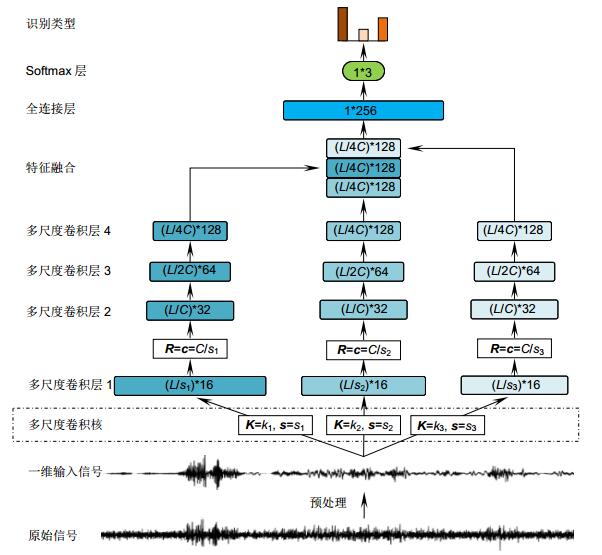-
摘要
针对相位敏感光时域反射(Φ-OTDR)分布式光纤振动传感系统如何对振动事件进行高效准确识别的问题,本文提出了一种基于多尺度一维卷积神经网络(MS 1-D CNN)的振动事件识别方法。该方法将原始振动信号经过预加重、归一化和谱减降噪的预处理操作后得到的一维信号,直接通过MS 1-D CNN实现端到端的振动信号特征的提取和识别。MS 1-D CNN在提取入侵振动信号特征时可兼顾信号时间和频率尺度,利用全连接层(FC layer)和Softmax层完成最终的识别过程,与二维卷积神经网络(2-D CNN)和一维卷积神经网络(1-D CNN)相比减少了待定参数数量。对破坏、敲击和干扰三类目标振动事件的光纤振动传感信号识别结果表明,MS 1-D CNN的识别正确率与2-D CNN相近,达到了96%以上,而处理速度提升一倍,在保持识别性能的前提下,有利于提高振动事件识别的实时性。

-
关键词:
- 分布式光纤振动传感 /
- 多尺度一维卷积神经网络 /
- 相位敏感光时域反射 /
- 振动事件识别 /
- 模式识别
Abstract
A new CNN-based deep neural network, multi-scale one-dimensional convolutional neural network (MS 1-D CNN) was proposed to improve the efficiency and accuracy of vibration event recognition for a phase-sensitive optical time-domain reflectometry (Φ-OTDR) distributed optical fiber vibration sensing system. The raw vibration signals are pre-processed first to remove noise as far as possible. The pre-processing operations include pre-emphasis filtering, normalization and spectral subtraction. The pre-processed signals are used as the inputs of MS 1-D CNN directly. MS 1-D CNN realizes the end-to-end feature extraction of vibration signals and finally recognizes the vibration events by using a fully-connected layer (FC layer) and a Softmax layer. In comparison with two-dimensional convolutional neural network (2-D CNN) and one-dimensional convolutional neural network (1-D CNN), the proposed method balances the time and frequency scales better during feature extraction and reduces the pending parameters of the whole neural network. A vibration recognition experiment was designed to classify the three types of the vibration events including damaging, knocking and interference. The recognition results show that MS 1-D CNN achieves similar recognition performance, over 96 percent, at twice processing speed compared to 2-D CNN. Therefore, it is beneficial to improve the real-timing of vibration monitoring while maintaining the recognition performance.
-
Overview

Overview: As a new type of sensing technology, the phase-sensitive optical time domain reflection (Φ-OTDR) distributed optical fiber sensing technology has the advantages of good environmental tolerance, low energy consumption, high sensitivity, long monitoring distance compared with traditional sensing technology, and has been the emphasis and hotspot of the researches. Among the manifold application fields of Φ-OTDR distributed optical vibration sensing system, identification of vibration events is one of the most popular and advantaged applications. Therefore, efficient and accurate identification of different vibration events is the focus of this paper. The recognition speed of traditional methods is fast, but their recognition rate and robustness are not ideal and strongly dependent on the artificial feature design. Although the method based on two-dimensional convolutional neural network (2-D CNN) has obtained a high recognition rate, the slow recognition speed and feature extraction process hamper its use in real-time systems. In view of the fact that one-dimensional convolutional neural network (1-D CNN) has been used in other real-time identification fields and achieved good results, this paper proposes a multi-scale one-dimensional convolutional neural network (MS 1-D CNN) method which takes the vibration signals as the input of this network and needs not to manually extract features. Feature extraction of the intrusion vibration signals in the MS 1-D CNN takes into account the rich feature information of the signals in time and frequency scales, thus achieves efficient and accurate identification. In order to control the spatial complexity and parameter quantity, three scales and four layers are used in the MS 1-D CNN method. The raw vibration signals are pre-processed firstly to remove noise as far as possible, including pre-emphasis filtering, normalization and spectral subtraction. The pre-processed waveform signals are directly inputted into the MS 1-D CNN, and the recognition results are achieved by using fully-connected layer (FC layer) and Softmax layer. In comparison with the methods based on 2-D CNN and 1-D CNN, the proposed method balances the time and frequency scales well during feature extraction and reduces the number of pending parameters. A vibration recognition experiment was designed to classify the three different vibration events, including damaging, knocking and interference. The recognition results show that MS 1-D CNN achieves similar recognition performance at twice processing speed compared to 2-D CNN. Hence, it is beneficial to improve the real-timing of vibration monitoring while maintaining the recognition performance.
-

-
表 1 Φ-OTDR分布式光纤振动传感系统仪器型号和主要参数
Table 1. Instrument model and key parameters of Φ-OTDR distributed optical vibration sensing system
窄线宽激光器 声光调制器 脉冲放大器 光电转换器 信号采集卡 传感光纤 仪器型号 Koheras AdjustiK E15 T-M080-0.4C2J-3-F2P PEFA-LP-CPM APD1D100ATBM FCFR-PCIe9826 黄色松套管光纤 参数配置 波长:1550 nm输出功率:34.5 mW 脉冲频率:1 kHz脉冲宽度:200 ns 平均输出功率:200 mW 最大数据传输率:2.5 Gb/s 采集速度:13 M samples/s 标准单模光纤折射率:1.46 表 2 三种算法模型识别结果
Table 2. Recognition results of three algorithm models
-
参考文献
[1] 蒋立辉, 盖井艳, 王维波, 等.基于总体平均经验模态分解的光纤周界预警系统模式识别方法[J].光学学报, 2015, 35(10): 1006002. http://www.wanfangdata.com.cn/details/detail.do?_type=perio&id=gxxb201510007
Jiang L H, Gai J Y, Wang W B, et al. Ensemble empirical mode decomposition based event classification method for the fiber-optic intrusion monitoring system[J]. Acta Optica Sinica, 2015, 35(10): 1006002. http://www.wanfangdata.com.cn/details/detail.do?_type=perio&id=gxxb201510007
[2] 朱程辉, 赵益, 王建平, 等.光纤入侵行为融合特征的集成识别[J].光电工程, 2016, 43(12): 6-12. doi: 10.3969/j.issn.1003-501X.2016.12.002
Zhu C H, Zhao Y, Wang J P, et al. Ensemble recognition of fiber intrusion behavior based on blending features[J]. Opto-Electronic Engineering, 2016, 43(12): 6-12. doi: 10.3969/j.issn.1003-501X.2016.12.002
[3] 况洋, 吴昊庭, 张敬栋, 等.分布式多参数光纤传感技术研究进展[J].光电工程, 2018, 45(9): 170678. doi: 10.12086/oee.2018.170678
Kuang Y, Wu H T, Zhang J D, et al. Advances of key technologies on distributed fiber system for multi-parameter sensing[J]. Opto-Electronic Engineering, 2018, 45(9): 170678 doi: 10.12086/oee.2018.170678
[4] Zhu H, Pan C, Sun X H. Vibration pattern recognition and classification in OTDR based distributed optical-fiber vibration sensing system[J]. Proceedings of SPIE, 2014, 9062: 906205. doi: 10.1117/12.2045268
[5] 张颜, 娄淑琴, 梁生, 等.基于多特征参量的Ф-OTDR分布式光纤扰动传感系统模式识别研究[J].中国激光, 2015, 42(11): 1105005. http://cdmd.cnki.com.cn/Article/CDMD-10004-1017058871.htm
Zhang Y, Lou S Q, Liang S, et al. Study of pattern recognition based on multi-characteristic parameters for Φ-OTDR distributed optical fiber sensing system[J]. Chinese Journal of Lasers, 2015, 42(11): 1105005. http://cdmd.cnki.com.cn/Article/CDMD-10004-1017058871.htm
[6] 李小玉, 吴慧娟, 彭正谱, 等.基于时间序列奇异谱特征的Φ-OTDR扰动检测方法[J].光子学报, 2014, 43(4): 0428001. http://d.old.wanfangdata.com.cn/Periodical/gzxb201404031
Li X Y, Wu H J, Peng Z P, et al. A novel time sequence singular spectrum analysis method for Φ-OTDR disturbance detection system[J]. Acta Photonica Sinica, 2014, 43(4): 0428001. http://d.old.wanfangdata.com.cn/Periodical/gzxb201404031
[7] Xu C J, Guan J J, Bao M, et al. Pattern recognition based on enhanced multifeature parameters for vibration events in Φ-OTDR distributed optical fiber sensing system[J]. Microwave and Optical Technology Letters, 2017, 59(12): 3134-3141. doi: 10.1002/mop.30886
[8] Xu C J, Guan J J, Bao M, et al. Pattern recognition based on time-frequency analysis and convolutional neural networks for vibrational events in Φ-OTDR[J]. Optical Engineering, 2018, 57(1): 016103. doi: 10.1117/1.OE.57.1.016103
[9] Ince T, Kiranyaz S, Eren L, et al. Real-time motor fault detection by 1-D convolutional neural networks[J]. IEEE Transactions on Industrial Electronics, 2016, 63(11): 7067-7075. doi: 10.1109/TIE.2016.2582729
[10] Kiranyaz S, Ince T, Gabbouj M. Real-time patient-specific ECG classification by 1-D convolutional neural networks[J]. IEEE Transactions on Biomedical Engineering, 2016, 63(3): 664-675. doi: 10.1109/TBME.2015.2468589
[11] Hu G, Wang K J, Peng Y, et al. Deep learning methods for underwater target feature extraction and recognition[J]. Computational Intelligence and Neuroscience, 2018, 2018: 1214301. http://www.wanfangdata.com.cn/details/detail.do?_type=perio&id=CC0214358814
[12] Pan Z Q, Liang K Z, Ye Q, et al. Phase-sensitive OTDR system based on digital coherent detection[J]. Proceedings of SPIE, 2011, 8311: 83110S. doi: 10.1117/12.905657
[13] Simonyan K, Zisserman A. Very deep convolutional networks for large-scale image recognition[OL]. arXiv: 1409.1556 [cs.CV].
[14] Ioffe S, Szegedy C. Batch normalization: accelerating deep network training by reducing internal covariate shift[C]//Proceedings of the 32nd International Conference on International Conference on Machine Learning, Lille, France, 2015: 448-456.
https://arxiv.org/abs/1502.03167 [15] Hinton G E, Srivastava N, Krizhevsky A, et al. Improving neural networks by preventing co-adaptation of feature detectors[OL]. arXiv: 1207.0580 [cs.NE].
[16] Sutskever I, Martens J, Dahl G, et al. On the importance of initialization and momentum in deep learning[C]//Proceedings of the 30th International Conference on International Conference on Machine Learning, Atlanta, GA, USA, 2013: Ⅲ-1139-Ⅲ-1147.
https://www.researchgate.net/publication/286271944_On_the_importance_of_initialization_and_momentum_in_deep_learning [17] He K M, Sun J. Convolutional neural networks at constrained time cost[C]//Proceedings of 2015 IEEE conference on computer vision and pattern recognition, Boston, MA, USA, 2015: 5353-5360.
http://www.oalib.com/paper/4067545 -
访问统计


 E-mail Alert
E-mail Alert RSS
RSS

 下载:
下载:







